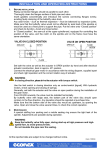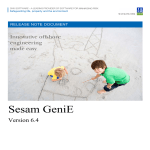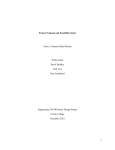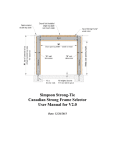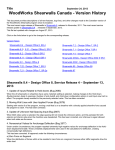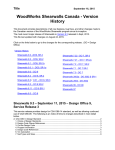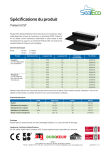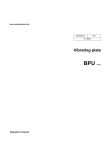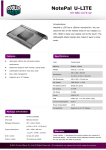Download LF10 USER'S MANUAL - CISC-ICCA
Transcript
LF10 LF10 User’s Manual LF10 USER'S MANUAL Lateral Forces 2010 LF10 User’s Manual User’s Manual Lateral Forces 2010 First Edition, September 2011 Copyright © 2011 All rights reserved. This manual or any part thereof must not be reproduced in any form without the written permission of the publisher. ISBN 978-0-88811-150-0 Canadian Institute of Steel Construction 3760 14th Avenue, Suite 200 Markham, Ontario L3R 3T7 Tel: (905) 946-0864 Email: [email protected] Website: www.cisc-icca.ca PREFACE PREFACE Prepared by the Canadian Institute of Steel Construction (CISC), the Lateral Forces 2010 (LF10) Excel spreadsheets for Wind and Seismic Loads replace the Lateral Forces 90 (LF90) program of the CISC Steel Design Series for the IBM Personal Computer and compatibles. The Microsoft Excel spreadsheets are part of a continuing effort by the Canadian structural steel industry to simplify the design of steel structures. Accordingly, LF10 joins the Handbook of Steel Construction and other design aids made available to designers by the Canadian Institute of Steel Construction. LF10 is based on the requirements of the National Building Code of Canada 2010, the Supplement to the National Building Code of Canada 2010 and CSA S16-09 Design of Steel Structures. The user must understand the design requirements of these documents before attempting to use the LF10 spreadsheets. In addition to explaining how to use the spreadsheets, this manual contains information relating to the design procedures and assumptions incorporated into the spreadsheets. Thus the designer will recognize the capabilities and limitations of the spreadsheets and, through the various options available, interject personal design requirements or engineering judgement. LF10 has been tested extensively and to the best of our knowledge, all data and information contained in both the spreadsheets and this manual were correct at the time of publication. The Canadian Institute of Steel Construction does not assume any responsibility for errors, misinterpretations or oversights resulting from the use of the Lateral Forces 2010 spreadsheets or this manual. Canadian Institute of Steel Construction 3 4 LF10 User’s Manual TABLE OF CONTENTS PREFACE .................................................................................................................................... 3 TABLE OF CONTENTS................................................................................................................. 4 CHAPTER 1 – PURPOSE ............................................................................................................. 7 CHAPTER 2 – GENERAL.............................................................................................................. 9 Hardware and Software Requirements ................................................................................ 9 Accessing the Spreadsheets .................................................................................................. 9 Design Standard .................................................................................................................... 9 Units .................................................................................................................................... 10 Data Input ........................................................................................................................... 10 Error Checking ..................................................................................................................... 10 Problem Size Limitations..................................................................................................... 10 Geometry and Sign Conventions ........................................................................................ 10 Output ................................................................................................................................. 11 Limitations........................................................................................................................... 12 Spreadsheet Protection ...................................................................................................... 12 Printing Reports .................................................................................................................. 12 CHAPTER 3 – WIND LOADS ..................................................................................................... 13 Lateral wind loads on the entire building – “Wind” sheet ................................................. 13 Reset Button ................................................................................................................... 13 Project information ......................................................................................................... 13 Level heights and dimensions - Input ............................................................................. 13 Site, importance category and terrain – Input ............................................................... 14 NBC climatic wind data and user-specified wind pressure ............................................ 14 Limit state, type of procedure and Building on hill – Input ............................................ 15 Forces and overturning on building – Output ................................................................ 15 CHAPTER 4 – SEISMIC LOADS .................................................................................................. 17 Reset Button ................................................................................................................... 17 Project Information ............................................................................................................. 17 Level Heights and Weights - Input ...................................................................................... 17 TABLE OF CONTENTS Site and Class - Input ........................................................................................................... 18 NBC site parameters and user-specified spectral accelerations .................................... 18 SFRS and Period for the X-direction - Input ........................................................................ 19 Forces and Distribution (X-direction) – Output .................................................................. 20 Force Multiplier for Deflection Calculations (X-Direction) ................................................. 24 Seismic Loads Calculations (Y-Direction) ............................................................................ 24 APPENDIX A – TECHNICAL NOTES (WIND) .............................................................................. 25 Effective Building Width ..................................................................................................... 25 APPENDIX B – TECHNICAL NOTES (SEISMIC) .......................................................................... 27 Method of Analysis, NBC 4.1.8.7 ........................................................................................ 27 SFRS General Restrictions, NBC 4.1.8.9 .............................................................................. 27 Post-Disaster Buildings, NBC 4.1.8.10 ................................................................................. 27 5 6 LF10 User’s Manual CHAPTER 1 – PURPOSE CHAPTER 1 – PURPOSE The CISC Lateral Forces 2010 spreadsheets (LF10) have been developed to compute lateral forces due to wind and/or earthquake according to the 2010 National Building Code of Canada. There are two separate spreadsheets for Wind and Seismic loads. Both use the same format for input and output. The Wind module (LF10-Wind) determines wind storey forces in each direction in accordance with either the Static Procedure for High-Rise or the Dynamic Procedure, which are given in Commentary I of the Structural Commentaries (Part 4 of Division B) to the National Building Code of Canada, 2010. The Speed-up over hills and escarpments is implemented. The Earthquake module (LF10-Seismic) determines seismic storey forces in accordance with the Equivalent Static Force Procedure of the NBC including Commentary J of the Structural Commentaries (Part 4 of Division B) to the National Building Code of Canada, 2010 and CSA S16-09. Design assumptions built into the spreadsheets have been kept to a minimum. When an assumption is made it is documented in the spreadsheets and in this manual. In this way the designer has complete control over the calculations. To facilitate validation and verifications, where possible and relevant, intermediate results are available and can be displayed as an option. 7 8 LF10 User’s Manual CHAPTER 2 – GENERAL CHAPTER 2 – GENERAL Prior to using the Lateral Forces 2010 spreadsheet, it is advisable to become familiar with a brief list of the spreadsheet's capabilities, features, and limitations. They are as follows: Hardware and Software Requirements The Microsoft Excel spreadsheet requires a version of Microsoft Excel be installed. The spreadsheet was optimized for use with Microsoft Excel 2007. Macros must be enabled to display more than the Welcome screen. To enable macros, go to “Excel options” → “Trust Center” → “Trust Center Settings” → “Macro Settings” and click on “Enable all macros”. You will then need to restart Excel for the new setting to be considered. To disable the Privacy warning that might be shown by Excel, go to “Developer Ribbon”, click “Macro Security”, click “Privacy Options” and uncheck all notifications. Accessing the Spreadsheets When you access the LF10 spreadsheets, either the Wind or Seismic module, the first worksheet you will encounter is the "Welcome" sheet containing an Introduction and Disclaimer. In order to proceed, you will need to obtain your Activation Key from CISC by following the instructions on the CISC website (www.cisc-icaca.ca). Type in your Activation Key in the cell at the bottom of the window and click the "ACCEPT DISCLAIMER AND ENTER" button to acknowledge the software license. You may save the workbook with your Activation Key to avoid having to enter it again in the future. As you access the spreadsheet, "zoom" settings for the different sheets are automatically adjusted to the window size. Design Standard Design standards include the National Building Code of Canada 2010 and the Structural Commentaries (Part 4 of Division B) to the National Building Code of Canada 2010. Seismic force increases based on the type of SFRS and the building height are determined according to CSA S16-09. 9 10 LF10 User’s Manual Units The International System of Units (SI), is used exclusively in LF10. The required units for each item of input data is given as the data is requested. In general, the units and abbreviations are as follows: length area force area load moment metres (m) square metres (m2) kilonewtons (kN) kilopascals (kPa) kilonewton metres (kN·m) Data Input The building geometry and design parameters are input using tables, cells and drop-down menus which appear on the screen. Data can be typed into the tables, pasted or dragged and copied from one cell to others. Input cells and drop-down menus are on a white background. Figure 1 - Input cell Error Checking During data input, possible errors are checked for input data type (e.g. words entered where a number is required) or data outside the normal range. When an error is found, a brief description is displayed, and the user is prompted to correct the input. To allow maximum flexibility, the permissible range of input values is wide. For example, when entering the period, Ta (mechanics), a decimal value between 0.1 and 99 must be entered. Figure 2 - Error warning for invalid data Problem Size Limitations The LF10 spreadsheet can compute forces for buildings up to 100 levels in height. Geometry and Sign Conventions The building geometry is specified in LF10 by entering the height, width and length of each level (Wind module only) and then stacking the levels vertically. The levels are numbered in ascending order starting at the bottom of the building with level number zero being ground. LF10-Seismic permits buildings with SFRS located along orthogonal axes only. Refer to the NBC for buildings for other SFRS orientations. CHAPTER 2 – GENERAL Building geometry and dimensions conventions in LF10 are shown on Figure 3. Wind Load X direction wx TYPICAL LEVEL wy y Building envelope reference x Wind Load Y direction Figure 3 - Building dimensions Wind forces act through the centre of geometry, while earthquake forces act through the centre of mass at each floor level. Output Output load tables are given by load type and principal building direction. In every load table generated, the output includes the lateral force, the cumulative shear and the cumulative overturning moment at the base of each level. The results of intermediate calculations are available and can be displayed by clicking the “check calculations” button, as shown on Figure 4. Figure 4 - Check calculations button All wind loads are factored. For design purposes, wind loads can be compared directly to the earthquake forces. Output is given in cells with a light yellow background. The level output is given as illustrated on Figure . While the applied force is at the top of a level, the overturning moment and shear for that level are at the base: 11 12 LF10 User’s Manual Level Roof ... 3 2 1 Base Froof F3 F2 F1 V4 M4 V3 M3 V2 M2 V1 M1 Figure 5 - Level output Limitations The spreadsheet can calculate lateral loads for buildings rectangular in plan only, and with flat roofs. Irregular building shapes must be approximated by a rectangular model. The building length and width may change from level to level, but any level rotated in the horizontal plane (about the vertical axis) must be approximated by a non-rotated level by the design engineer. The spreadsheet will not perform a structural analysis or a dynamic analysis. The purpose of the spreadsheet is not to replace calculations performed by a design engineer, but to assist the engineer in computing lateral loads. It would be impractical to provide a complete, step-by-step illustration of wind or earthquake calculations, whether the design is performed manually or by means of a spreadsheet. Therefore, output from LF10 provides sufficient key information about each load combination, so that the results can be easily verified by a qualified design engineer. It is left to the design engineer to verify load calculations and judge their applicability with respect to design criteria. Spreadsheet Protection The spreadsheet is protected – some cells cannot be modified but can be selected, for example to copy the results. Printing Reports Excel printing options can be used to print reports. It is recommended to adjust the position of page breaks according to the number of levels in the building. CHAPTER 3 – WIND LOADS CHAPTER 3 – WIND LOADS LF10-Wind can calculate lateral wind loads either according to the static procedure for highrise buildings or the dynamic procedure. The user is responsible for choosing the appropriate method. Ultimate limit states and serviceability limit states can be considered separately. The wind is assumed to act in either of the two principal building directions through the centre of geometry of the given level. Only horizontal loads are computed; vertical wind pressures acting on the roof are not included. And only overall loads acting on the entire building's lateral load-resisting system are computed. The applicability of the Static or Dynamic Procedure is not checked by LF10-Wind. (See Article 4.1.7.2 and Figure I-1) Wind forces generated by the spreadsheet are to be used for strength and deflection design of structural lateral load-resisting systems; they are not applicable to the design of cladding. In LF10-Wind, the internal pressure, pi, is not considered to affect loads on the building structure since the windward and leeward faces are assumed to be vertical and identical for each direction. The need to consider internal pressure, pi, should be reviewed by the project engineer. Lateral wind loads on the entire building – “Wind” sheet This sheet performs load calculations for the entire building without consideration of torsion. Partial or unbalanced load conditions are not included. Reset Button Click on the Reset button to initialize the input data. Project information The user can enter the date, a project designation and fill the “prepared by” box to identify projects on the screen and on a printed report. The contents of those fields are not used by the spreadsheet. Level heights and dimensions - Input The number of levels must be an integer from 1 to 100. This value is used to adjust the number of data cells for input and output. A minimum of 8 levels is shown. Please note that if the number of levels is changed after entering the level data, all data previously entered for levels above the new number will be lost. The inter-storey height (hs) for each level must be a decimal value in metres between 0.1 and 99. DX is the building width at a given level for wind loading acting in the X direction, and DY is the width for wind loading in the Y direction. These dimensions are used in the calculation 13 14 LF10 User’s Manual of tributary areas. They should be representative of the entire building envelope and thus include the thickness of cladding. A roof parapet with a height of up to 1.5 m can be added to the roof level. The parapet dimensions in the X and Y directions are the same as the dimensions of the roof level. The parapet is not included in the building height for subsequent calculations. Optionally, dimensions at the base, the total height and effective widths in both directions can be displayed. Effective widths are calculated according to NBC Article 4.1.7.2. Site, importance category and terrain – Input LF10 – Wind incorporates the climatic data from Appendix C of the NBC 2010. Both the province and the city are listed alphabetically. Note that cities which are part of a metropolitan region are not grouped as in Appendix C. Thus, for example, North York will not be listed under Toronto but under its own name. The province and location of the building are selected by means of a drop-down menu. The location list is updated when the province is changed. When the province is changed, the first location name is initially selected. The Reference velocity pressure q1/50 is the one given in Appendix C. The importance category of the building is selected through a drop-down menu. Available choices are given in NBC Table 4.1.7.1. The terrain type is also selected through a drop-down menu. Open terrain exposure (Exposure A) and Rough terrain exposure (Exposure B) can be selected. Exposure C in the dynamic procedure of the NBC is not implemented in LF10-Wind. Exposure C should be used with caution and only in the centre of large cities. LF10-Wind does not permit interpolation between exposures. NBC climatic wind data and user-specified wind pressure The user may select a user-specified pressure by checking the box located directly under the Reference velocity pressure input box. Alternatively, the NBC 2010 climatic wind data for the location may be used (by unchecking the box). CHAPTER 3 – WIND LOADS Limit state, type of procedure and Building on hill – Input The limit state for calculating wind loads is selected through a drop-down menu. Ultimate limit states and Serviceability limit states are the available selections, which will affect the value of the Importance factor, IW, according to Table 4.1.7.1. The desired procedure for wind load calculation is selected through another drop-down menu. No additional input is necessary for the Static Procedure. If the Dynamic Procedure is selected, the user must input β, the critical damping ratio for the building, and natural frequencies of vibration fnD,X and fnD,Y for the X and Y directions, respectively. It is noted that the empirical formulas for period calculations used in seismic design should not be used for wind forces. If desired, the effects of wind speed-up over hills and escarpments can be included in accordance with paragraphs 13 to 16 and 21 of Commentary I and for both the Static and Dynamic Procedures. The choice of hill and escarpment shape and parameters for maximum speed-up is given according to Table I-1. If a hill or escarpment is selected, the user must also input: • • • Hh, the height of the hill or escarpment or the difference in elevation between the crest and the terrain surrounding the hill or escarpment upwind. Negative values of Hh are beyond the scope of LF10-Wind. Lh, the distance upwind of the crest to where the ground elevation is half of Hh x, a horizontal distance from the crest The spreadsheet includes figures describing the hill or escarpment geometry as needed. Only one amplification factor for speed-up is considered for the entire building. If a hill is specified, the speed-up will affect both the X and Y directions. Also, conservatively, the same x distance is used for the windward and the leeward faces of the building. Optionally, the user can display the factors used for the calculation of Ce*/Ce. The maximum speed-up factor at the base level of the building (i.e. at the top of the hill) is also provided. Forces and overturning on building – Output By clicking the “check calculations” button below the title of the section, the user can display the values of Cp, Ce (or Ce*) and Cg (or Cg*) used in wind pressure calculations. Values of Ce (or Ce*) and Cg (or Cg*) are given for each level. These coefficients are also computed at an elevation above the base equal to a quarter of the height of the first level. In the next drop-down menu, available only if Ultimate Limit States are selected, the user must indicate whether the wind loads act as a Principal Load of as a Companion Load. This will affect the Load factor, which is then displayed below. For Serviceability Limit States, the load factor is invariably 1.0. 15 16 LF10 User’s Manual The output of this sheet is presented in the form of a table of applied forces (F), shears (V) and overturning moments (M), for each direction and level. For each level, the output is given as illustrated on Figure 6. While the applied force is at the top of a level, the overturning moment and shear given for that level are referred to its base. For wind force calculations, tributary areas at a given level generally include half of the level heights immediately above and below the level. For the roof, the tributary area includes half of the level below and the entire area of the parapet above. At the base level, the wind on the bottom half of the first level is considered to be transmitted directly to the foundation. This force, F0 , is only included in the output for the shear force corresponding to the entire building at the base, for purposes of foundation design. If necessary, the value of F0 can be calculated by subtracting the shear for level 1 from the shear of the entire building at the base. In calculating the overturning moment, the point of application of the wind force on the parapet is taken at its mid-height. Figure 6 illustrates the tributary areas and applied wind forces for the entire building. Level Roof ... 3 2 1 Base parapet Froof F3 F2 F1 F0 Figure 6 - Tributary areas for wind forces CHAPTER 4 – SEISMIC LOADS CHAPTER 4 – SEISMIC LOADS The lateral earthquake design force at the base of the structure, V, is computed and distributed according to NBC 2010 Article 4.1.8 of the NBC 2010. The Equivalent Static Force Procedure for Structures Satisfying the Conditions of Article 4.1.8.7 is used to determine static loads. LF10 – Seismic will perform load calculations for the selected location and type of Seismic Force-Resisting System (SFRS). A warning will appear if a system not allowed by the NBC is selected. The user should use the CISC Steel Seismic Systems software to determine which systems are allowed for the location and building height, and to verify whether S(0.2) is less than or equal to 0.12, in which case the requirements of Article 4.1.8 need not apply. Reset Button Click on the Reset button to initialize the input data. Project Information The user can enter the date, a project designation and fill in the “prepared by” box to identify projects both on the screen and on a printed report. The contents of those fields are not used by the spreadsheet. Level Heights and Weights - Input The number of levels must be an integer from 1 to 100. This input value is used to display the appropriate number of data cells for input and output results. A minimum of 8 levels of input and output are shown when a figure is used to illustrate the table. Please note that if the number of levels is changed, all data entered for levels above the new number of levels will be lost. The inter-storey height (hs) for each level must be a decimal value in metres between 0.1 and 99. 'W' is the dead load, or weight, assigned to each level. The dead load is defined in Article 4.1.4.1. The dead load assigned to each level must be a positive value. For reference and verification, both the sum of the inter-storey heights and the total dead load are given at the bottom of the table. The input values for inter-storey height and weight for each level are shown on Figure 7: 17 18 LF10 User’s Manual Level Roof ... 3 2 1 Base Wroof hs,roof W3 W2 hs,3 W1 hs,2 hs,1 Figure 7 - Level height and weight input Site and Class - Input LF10 – Seismic incorporates the climatic data from Appendix C of the NBC 2010. Both the province and the city are listed alphabetically. Note that cities which are part of a metropolitan region are not grouped as in Appendix C. Thus, for example, North York will not be listed under Toronto but under its own name. The province and location of the building are selected by means of a drop-down menu. The location list is updated when the province is changed. When the province is changed, the first location name is initially selected. The spectral response acceleration values Sa(T) for periods T of 0.2s, 0.5s, 1.0s and 2.0s are the values given in Appendix C. The importance category of the building is selected through a drop-down menu. Available choices are given in NBC Table 4.1.8.5, and the importance factors for ULS given in the table are used in the spreadsheet. Note that NBC stipulates additional system restrictions to Postdisaster buildings (refer to Article 4.1.8.10). Site classification depending on the ground profile is based on Table 4.1.8.4.A. of NBC 2010. When Site Class F is selected, the used can directly input values of acceleration and velocitybased coefficients Fa and Fv. Refer to the NBC for more information on selecting the appropriate Site Class. Acceleration and velocity-based coefficients Fa and Fv are based on Tables 4.1.8.4.B. and 4.1.8.4.C. and are linearly interpolated for intermediate values of Sa(0.2) and Sa(1.0). Values of the design spectral acceleration S(T) are determined as follows: S(T) = FaSa(0.2) for T = 0.2 s = FvSa(0.5) or FaSa(0.2), whichever is smaller for T = 0.5 s = FvSa(1.0) for T = 1.0 s = FvSa(2.0) for T = 2.0 s = FvSa(2.0)/2 for T ≥ 4.0 s NBC site parameters and user-specified spectral accelerations You may enter user-specified spectral accelerations by checking the box, "Check to enter user-specified spectral accelerations". Alternatively, the NBC 2010 seismic data for the CHAPTER 4 – SEISMIC LOADS 19 location may be used (by unchecking the box). SFRS and Period for the X-direction - Input Table 1 indicates the different available steel seismic force-resisting systems in LF10-Seismic together with their corresponding Rd and Ro factors, the NBC formula used for the period calculation and limits on the period for strength and deflection calculations. Table 1 – Seismic Force-Resisting Systems Structural system Rd Ro Ta (NBC) 1.5 0.085 (hn)0.75 Limit strength 1.5 Ta Limit deflect. 2.0 s Ductile moment-resisting frame 5.0 Moderately ductile moment-resisting frame 3.5 1.5 0.085 (hn)0.75 1.5 Ta 2.0 s Limited ductility moment-resisting frame 2.0 0.75 1.3 0.085 (hn) 1.5 Ta 2.0 s Moderately ductile concentrically braced frame Tension-compression braces Moderately ductile concentrically braced frame Tension-only braces Limited ductility concentrically braced frame Tension-compression braces Limited ductility concentrically braced frame Tension-only braces Ductile buckling-restrained braced frame 3.0 1.3 0.025 hn 2.0 Ta 2.0 s 3.0 1.3 0.025 hn 2.0 Ta 2.0 s 2.0 1.3 0.025 hn 2.0 Ta 2.0 s 2.0 1.3 0.025 hn 2.0 Ta 2.0 s 4.0 1.2 0.025 hn 2.0 Ta 2.0 s Ductile eccentrically braced frame 4.0 1.5 0.025 hn 2.0 Ta 2.0 s 0.75 2.0 Ta 4.0 s 2.0 Ta 4.0 s Ductile plate wall 5.0 1.6 0.05 (hn) Limited ductility plate wall 2.0 1.5 0.05 (hn)0.75 Conventional construction - Assembly occupancies Moment-resisting frame Conventional construction - Assembly occupancies Braced frame Conventional construction - Assembly occupancies Shear wall Conventional construction - Occupancies other than Assembly - Moment-resisting frame Conventional construction - Occupancies other than Assembly - Braced frame Conventional construction - Occupancies other than Assembly - Shear wall Other steel SFRS (not defined in Table 4.1.8.9) 0.75 1.5 1.3 0.085 (hn) 1.5 Ta 2.0 s 1.5 1.3 0.025 hn 2.0 Ta 2.0 s 1.5 1.3 0.05 (hn)0.75 2.0 Ta 4.0 s 1.5 1.3 0.085 (hn)0.75 1.5 Ta 2.0 s 1.5 1.3 0.025 hn 2.0 Ta 2.0 s 1.5 1.3 0.05 (hn)0.75 2.0 Ta 4.0 s 1.0 1.0 0.05 (hn)0.75 1.0 Ta 2.0 s 20 LF10 User’s Manual For the fundamental period calculation, the sum of the storey heights is used by default. To modify the value and enter the height above the base to level n (the uppermost level in the main portion of the structure), check the box "Check to input a different value, uncheck to use the sum of storey heights". The entered value must be between 0 and the sum of the storey heights. The user must specify the type of SFRS. LF10 then calculates the fundamental period of the system according to NBC (Tformula). LF10 enables the user to enter a fundamental period in the direction under consideration by means of other established methods of mechanics (Tmechanics) using a structural model that complies with the requirements of Sentence 4.1.8.3.(8). This is done by checking box “Check to input a different value”. Forces and Distribution (X-direction) – Output The upper limits to the period Ta, as given in Article 4.1.8.11, are used to determine the fundamental period Ta used in load calculations. Those limits are given in Table 1 under the “Limit strength” column. The spectral acceleration, S(Ta), is linearly interpolated from S(T) values. The higher-mode factor, Mv, and its associated base overturning moment reduction factor, J, are based on Table 4.1.8.11. For S(Ta)Mv, the interpolation is carried out using the product S(T)Mv. While any SFRS can be selected, LF10 checks the NBC height restrictions according to Table 2. This verification is done using the sum of the storey heights even if a lower value of Hn is entered for the fundamental period calculation. For Post-Disaster buildings, only ductile systems (Rd ≥ 2.0) are allowed. If the selected system is not allowed, a warning will appear, together with a box “Check to continue anyway”. If the selected SFRS is not allowed, this box must be checked in order to display the output. A graph showing the modified design spectral acceleration S(T)Mv will be displayed. For systems with Rd ≥ 1.5 and a site class other than F, the upper limit for the base shear is displayed on the graph. The red circle indicates the final acceleration used for the base shear calculation, including the S16-09 amplification for height, if applicable. The equivalent Static Force Procedure for structures satisfying the conditions of Article 4.1.8.7 is then used to calculate the base shear. CHAPTER 4 – SEISMIC LOADS 21 Table 2 - Height limits used in LF10 Structural system Restrictions IEFaSa(0.2) <0.2 ≥ 0.2 to ≥ 0.35 to <0.35 <0.75 IEFvSa(1.0) >0.75 >0.3 Ductile moment-resisting frame NL NL NL NL NL Moderately ductile moment-resisting frame NL NL NL NL NL Limited ductility moment-resisting frame NL NL 60 30 30 Moderately ductile concentrically braced frame Tension-compression braces Moderately ductile concentrically braced frame Tension only braces Limited ductility concentrically braced frame - Tensioncompression braces Limited ductility concentrically braced frame - Tensiononly braces Ductile buckling-restrained braced frame NL NL 40 40 40 NL NL 20 20 20 NL NL 60 60 60 NL NL 40 40 40 NL NL 40 40 40 Ductile eccentrically braced frame NL NL NL NL NL Ductile plate wall NL NL NL NL NL Limited ductility plate wall NL NL 60 60 60 Conventional construction - Assembly occupancies Moment-resisting frame Conventional construction - Assembly occupancies Braced frame Conventional construction - Assembly occupancies Shear wall Conventional construction - Occupancies other than Assembly - Moment-resisting frame Conventional construction - Occupancies other than Assembly - Braced frame Conventional construction - Occupancies other than Assembly - Shear wall Other steel SFRS (not defined in Table 4.1.8.9) NL NL 15 15 15 NL NL 15 15 15 NL NL 15 15 15 NL NL 60 40 40 NL NL 60 40 40 NL NL 60 40 40 15 15 NP NP NP NL = system is not limited in height, NP = system is not permitted The minimum lateral earthquake force, Vmin, based on the weight, W, is obtained from the formula in 4.1.8.11(2): 22 LF10 User’s Manual A second minimum lateral earthquake force, Vmin2, for wall systems is given in 4.1.8.11(2)(a): . and for all other systems in 4.1.8.11(2)(b): . The maximum lateral earthquake force, Vmax, is calculated according to 4.1.8.11(2)(c): . The base shear V, as a function of the weight W, is thus obtained from: 1) For Rd≥ 1.5 and a Site Class other than F: 2) For all other systems: MAX MIN , MAX , , An amplification factor for the base shear, "A", based on requirements in S16-09 is then calculated. Table 3 lists the systems affected by this increase and the respective formula used for calculating the amplification factor. CHAPTER 4 – SEISMIC LOADS 23 Table 3 - Amplification factors in S16-09 Structural system Base Shear Amplification Factor (A) Moderately ductile concentrically braced frame - Tensioncompression braces, Clause 27.5.2.3 MIN(1.24,IF(hn>32,1+(hn-32)*0.03,1)) Moderately ductile concentrically braced frame - Tension only braces, Clause 27.5.2.5 MIN(1.12,IF(hn>16,1+(hn-16)*0.03,1)) Limited ductility concentrically braced frame - Tensioncompression braces, Clause 27.6.2.1 MIN(1.24,IF(hn>48,1+(hn-48)*0.02,1)) Limited ductility concentrically braced frame - Tension-only braces, Clause 27.6.2.3 MIN(1.24,IF(hn>32,1+(hn-32)*0.03,1)) Conventional construction - Occupancies other than Assembly Moment-resisting frame, Clause 27.11.3(a) IF (IEFaSa(0.2)≥0.35, Conventional construction - Occupancies other than Assembly Braced frame, Clause 27.11.3(a) MIN(IF(hlimit*=60,1.9,1.5), IF(hn>15,1+(hn -15)*0.02,1)),1) Conventional construction - Occupancies other than Assembly Shear wall, Clause 27.11.3(a) * Where hlimit is the applicable height limit from Table 2. The maximum lateral earthquake force, Vmax,RdRo =1.3, is given by: , . . The amplified base shear is obtained as follows: 1) For Conventional construction - Occupancies other than Assembly: MIN , . ,V A 2) For all other systems: The final base shear V used in the level distribution is given by: 24 LF10 User’s Manual The lateral seismic force at each level Fx is computed according to 4.1.8.11(6): ∑ where Wx and hx are the portion of W and the height at level x, respectively. The additional force at the top, Ft is defined by: 0.07 Ft need not exceed 0.25V, and is set equal to zero when Ta ≤ 0.7s. The overturning moment at level x is calculated by: For conventional construction and other systems, Mx is multiplied by a reduction factor Jx (4.1.8.11 (7)): 1 1) When hx < 0.6 hn: 2) For all other cases: . 1.0 Force Multiplier for Deflection Calculations (X-Direction) NBC 2010 allows the use of Ta = Tmechanics for the purpose of calculating deflections (Tdeflections), subject to the limits given in Article 4.1.8.11.3(d)(v) and listed in Table 1 under the “Limit deflections” column. Base shear calculations, as described above for the X-direction (for strength: Vstrength) are then carried out using Tdeflections in order to obtain Vdeflections. The seismic force multiplier for deflections is then calculated as Vdeflections / Vstrength. Seismic Loads Calculations (Y-Direction) On a separate sheet, the user can select a different SFRS and specify a different value of Ta (mechanics) for the Y-direction. Otherwise, input, calculations and output are identical to that for the X-direction. APPENDIX A – TECHNICAL NOTES (WIND) APPENDIX A – TECHNICAL NOTES (WIND) As a supplemental reference, the following pages describe the engineering formulas incorporated into the LF10 software. For a complete nomenclature of variables, please refer to the National Building Code of Canada (NBC 2010). Effective Building Width Optionally, dimensions at the base, the total height and effective widths in both directions can be displayed. The effective building width for wind loads is calculated according to Clause 4.1.7.2 as follows: ∑ ∑ Where hi is the height above the base to level i. 25 26 LF10 User’s Manual APPENDIX B – TECHNICAL NOTES (SEISMIC) APPENDIX B – TECHNICAL NOTES (SEISMIC) Particular restrictions pertaining to seismic design according to the National Building Code of Canada (NBC) 2010 are listed below. Method of Analysis, NBC 4.1.8.7 The user is responsible for determining the applicable method of analysis, either the Equivalent Static Force Procedure described in Article 4.1.8.11, or the Dynamic Analysis Procedure described in 4.1.8.12. Only the former method is included in LF10-Seismic. SFRS General Restrictions, NBC 4.1.8.9 If the chosen SFRS violates 4.1.8.9, either because of a building height limitation or because of the value of Ie Fa Sa(0.2), a warning will appear in the worksheet. Post-Disaster Buildings, NBC 4.1.8.10 The user must verify that Post-disaster buildings meet the requirements of 4.1.8.10, in particular with regard to structural irregularities (Table 4.1.8.6). Also, a warning will be displayed if Rd < 2. 27



























